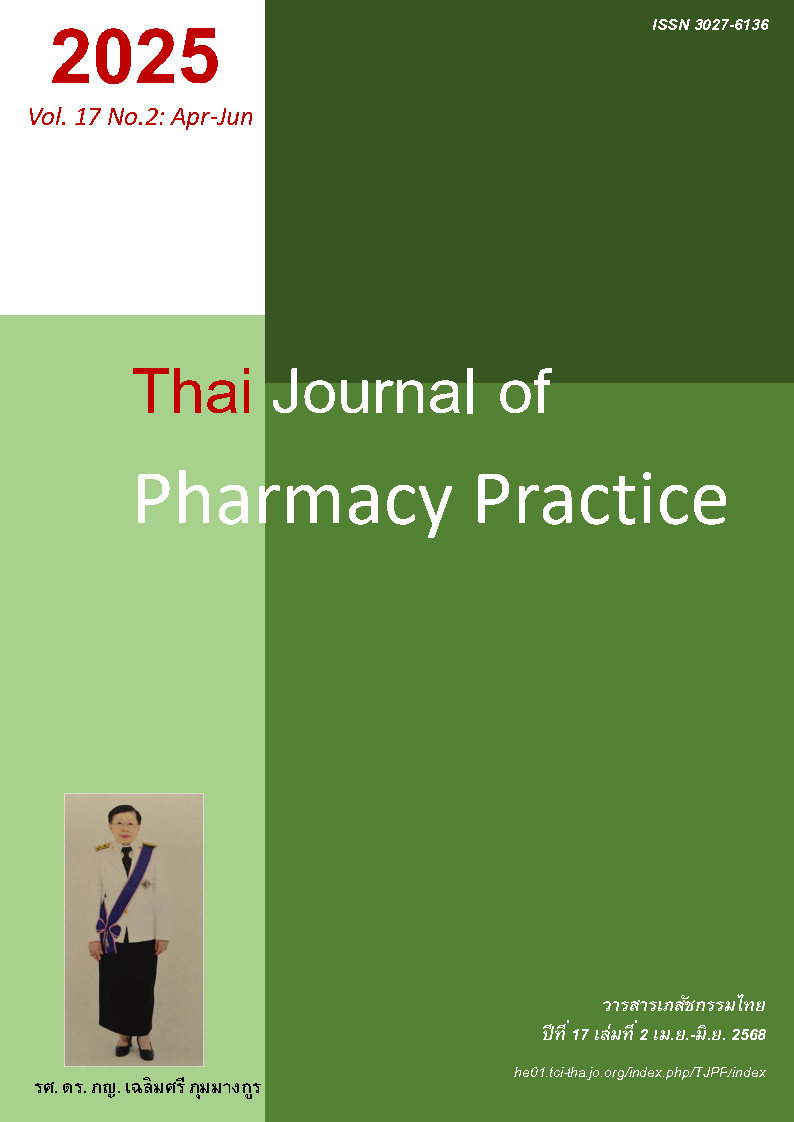ประสิทธิภาพและความปลอดภัยจากการใช้ยา enalapril ขนาดสูงเปรียบเทียบกับ การใช้ enalapril ขนาดต่ำร่วมกับ manidipine ในผู้ป่วยเบาหวานชนิดที่ 2 ที่มี โรคความดันโลหิตสูงและมีภาวะอัลบูมินนูเรีย: การทดลองสุ่มแบบเปิดที่มีกลุ่มควบคุม
Main Article Content
บทคัดย่อ
วัตถุประสงค์: เพื่อศึกษาประสิทธิภาพและความปลอดภัยจากการใช้ enalapril ขนาดสูง เปรียบเทียบกับการใช้ enalapril ขนาดต่ำร่วมกับ manidipine ในผู้ป่วยเบาหวานชนิดที่ 2 ที่ยังไม่สามารถควบคุมความดันโลหิตได้ตามเป้าหมายและมีภาวะอัลบูมินนูเรีย วิธีการ: การศึกษาเชิงทดลองแบบสุ่มที่มีกลุ่มควบคุมแบบเปิดครั้งนี้ทำที่โรงพยาบาลป่าซาง จังหวัดลำพูน แบ่งผู้ป่วยเป็น 2 กลุ่มคือ กลุ่มควบคุมได้รับ enalapril ขนาดสูง (30 - 40 mg/วัน) และกลุ่มทดลองได้รับ enalapril ขนาดต่ำ (5 - 20 mg ต่อวัน) ร่วมกับ manidipine (10 - 20 mg/วัน) เก็บข้อมูล 24 สัปดาห์ ติดตามผลการรักษา 3 ครั้ง (วันที่ 0, สัปดาห์ที่ 12 ± 2, และสัปดาห์ที่ 24 ± 2) วิเคราะห์ผลแบบ modified intention to treat ในผู้ป่วยที่ได้รับยาที่ใช้ในการศึกษาอย่างน้อย 1 ครั้ง ทดสอบความแตกต่างของตัวแปรระหว่างกลุ่มด้วยสถิติ t-test หรือ Fisher’s exact test และเปรียบเทียบผลการรักษาโดยใช้ Generalized Estimating Equation (GEE) ผลการวิจัย: enalapril ขนาดสูง และ enalapril ขนาดต่ำร่วมกับ manidipine ลดระดับความดันโลหิตของผู้ป่วยที่มีภาวะอัลบูมินนูเรียได้ดีไม่แตกต่างกัน การใช้ enalapril ขนาดสูงมีประสิทธิภาพในการลดระดับ UACR (urine albumin to creatinine ratio) ในผู้ป่วยที่มีภาวะแมคโครอัลบูมินนูเรียมากกว่าการใช้ enalapril ขนาดต่ำร่วมกับ manidipine อย่างมีนัยสำคัญทางสถิติ ในขณะที่ประสิทธิภาพของการรักษาทั้งสองรูปแบบในผู้ป่วยที่มีภาวะไมโครอัลบูมินนูเรียไม่แตกต่างกัน ในด้านความปลอดภัยผู้ป่วยกลุ่มที่ได้รับ enalapril ขนาดสูงเกิดอาการไอสูงกว่ากลุ่มที่ได้รับ enalapril ขนาดต่ำร่วมกับ manidipine อย่างมีนัยสำคัญทางสถิติ สำหรับอาการข้างเคียงอื่น ๆ พบอุบัติการณ์ไม่แตกต่างกัน สรุป: ผู้ป่วยเบาหวานชนิดที่ 2 ที่ยังไม่สามารถควบคุมระดับความดันโลหิตได้และมีภาวะแมคโครอัลบูมินนูเรียแนะนำให้รักษาด้วยยา enalapril ขนาดสูง ผู้ป่วยที่มีภาวะไมโครอัลบูมินนูเรียสามารถให้การรักษาได้ทั้งการใช้ enalapril ขนาดต่ำร่วมกับ manidipine และการใช้ enalapril ขนาดสูง
Article Details

This work is licensed under a Creative Commons Attribution-NonCommercial-NoDerivatives 4.0 International License.
ผลการวิจัยและความคิดเห็นที่ปรากฏในบทความถือเป็นความคิดเห็นและอยู่ในความรับผิดชอบของผู้นิพนธ์ มิใช่ความเห็นหรือความรับผิดชอบของกองบรรณาธิการ หรือคณะเภสัชศาสตร์ มหาวิทยาลัยสงขลานครินทร์ ทั้งนี้ไม่รวมความผิดพลาดอันเกิดจากการพิมพ์ บทความที่ได้รับการเผยแพร่โดยวารสารเภสัชกรรมไทยถือเป็นสิทธิ์ของวารสารฯ
References
Basi S, Fesler P, Mimran A, Lewis JB. Microalbumi- nuria in type 2 diabetes and hypertension: a marker, treatment target, or innocent bystander? Diabetes Care 2008; 31(Supplement_2): S194-201.
Jerums G, MacIsaac RJ. Treatment of microalbumi- nuria in patients with type 2 diabetes mellitus. Treat Endocrinol 2002; 1: 163-73.
Ahmad T, Ulhaq I, Mawani M, Islam N. Microalbumi- nuria in type-2 diabetes mellitus; the tip of iceberg of diabetic complications. Pak J Med Sci. 2017; 33: 519-23.
Society TH. Thai guidelines on the treatment of hypertension. Chiang Mai: Trickthink; 2019.
Tong PC, Chan SC, Chan W-B, Ho KK, Leung GT, Lo SH, et al. Consensus statements from the diabetologists & endocrinologists alliance for the management of people with hypertension and type 2 diabetes mellitus. J Clin Med 2023; 12: 3403. doi: 10.3390/jcm12103403
Kunz R, Friedrich C, Wolbers M, Mann JF. Meta-analysis: effect of monotherapy and combination therapy with inhibitors of the renin angiotensin system on proteinuria in renal disease. Ann Intern Med. 2008; 148: 30-48.
SaizSatjes M, Martinez-Martin FJ. Manidipine: an antihypertensive drug with positive effects on metabolic parameters and adrenergic tone in patients with diabetes. Drugs Context 2018; 7: 212509.
Schmieder RE. Cardiovascular risk management - efficacy of manidipine in hypertension and beyond. Eur Cardiol 2008; 4: 69–74.
Kidney Disease: Improving Global Outcomes (KDIGO) Glomerular Diseases Work Group. KDIGO 2021 clinical practice guideline for the management of glomerular diseases. Kidney Int. 2021; 100: S1-276.
Williams B, Mancia G, Spiering W, Agabiti Rosei E, Azizi M, Burnier M, et al. 2018 ESC/ESH guidelines for the management of arterial hypertension: the task force for the management of arterial hypertension of the European Society of Cardiology (ESC) and the European Society of Hypertension (ESH). Eur Heart J 2018; 39: 3021-104.
Singh VK, Mishra A, Gupta KK, Misra R, Patel ML, Shilpa. Reduction of microalbuminuria in type-2 diabetes mellitus with angiotensin-converting enzyme inhibitor alone and with cilnidipine. Indian J Nephrol 2015; 25: 334-9.
Mongkolsomlit S, Rawdaree P. Factors Affecting microalbuminuria in type 2 diabetes: meta-analysis. Srinagarind Med J 2010; 25: 185-93.
Techawarutama K, Supasyndh O, Chaiprasert A, Nata N, Satirapoj B, editors. Efficacy of high dose enalapril vs combination low dose enalapril and manidipine on albuminuria in hypertensive type 2 diabetic patients: a randomized controlled trial. The 35th Annual Meeting The Royal College of Physicians of Thailand; 2019 2019 Apr 25-27; Pattaya, Chonburi.
Schjoedt KJ, Astrup AS, Persson F, Frandsen E, Boomsma F, Rossing K, et al. Optimal dose of lisinopril for renoprotection in type 1 diabetic patients with diabetic nephropathy: a randomised crossover trial. Diabetologia. 2009; 52: 46-9.
Rossing K, Schjoedt KJ, Jensen BR, Boomsma F, Parving HH. Enhanced renoprotective effects of ultrahigh doses of irbesartan in patients with type 2 diabetes and microalbuminuria. Kidney Int. 2005; 68: 1190-8.
Burgess E, Muirhead N, Rene de Cotret P, Chiu A, Pichette V, Tobe S. Supramaximal dose of candesartan in proteinuric renal disease. J Am Soc Nephrol 2009; 20: 893-900.
Dicpinigaitis PV. Angiotensin-converting enzyme inhibitor-induced cough: ACCP evidence-based clinical practice guidelines. Chest. 2006; 129: 169s-73s.
Fares A. Winter hypertension: potential mechanisms Int J Health Sci (Qassim) 2013; 7: 210-9.
Park S, Kario K, Chia YC, Turana Y, Chen CH, Bura- nakitjaroen P, et al. The influence of the ambient temperature on blood pressure and how it will affect the epidemiology of hypertension in Asia. J Clin Hypertens (Greenwich) 2020; 22: 438-44.

